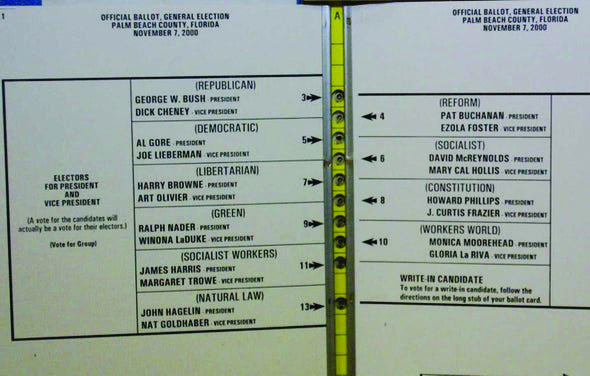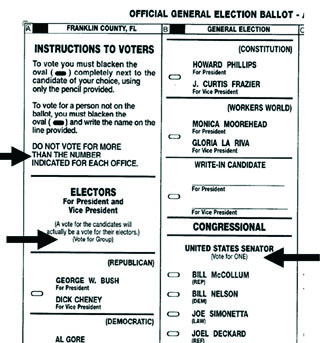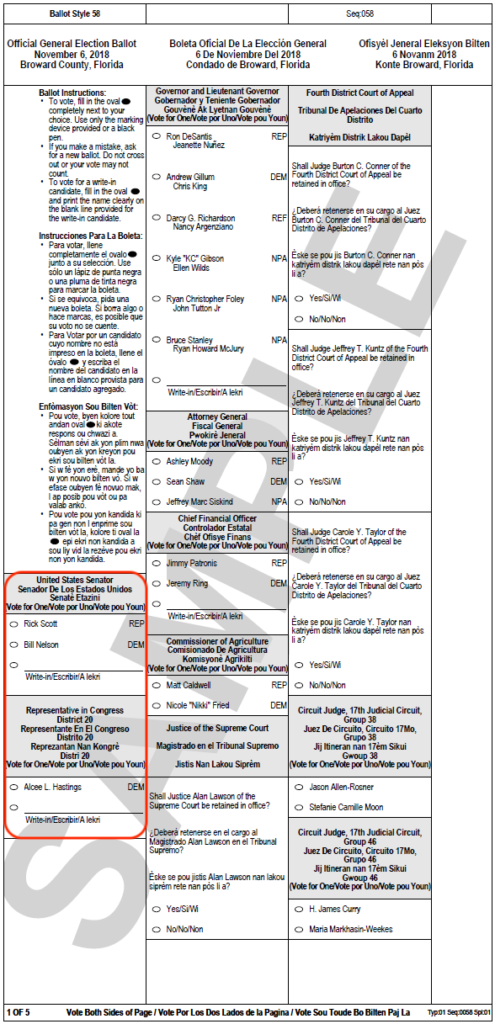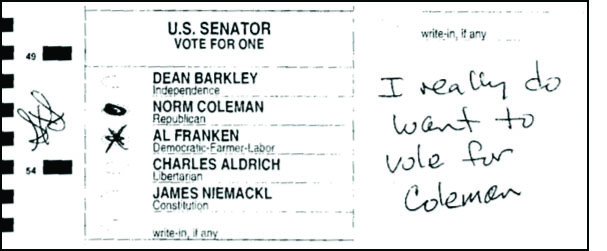Featured
Making Votes Count: It’s as Much About Psychology (and Ballot Design) as Security
Applied psychologists and human factors engineers can apply their skills to make a real difference in ensuring that ballots accurately capture voter intent.

In the highly unusual U.S. election year of 2020 in particular, maintaining secure voting systems, whether electronic or paper-based, in person or by mail, is crucial to ensuring that the democratic process works as it should (Brennan Center for Justice, 2016). Ever since the 2016 presidential election in the United States, when allegations of Russian interference dominated the news, the focus of many voters (and most election experts) has been on the security of our voting systems.
Further Research on Factors Affecting Political Participation
Psychological research around the world has explored how variables involving ballots, voter and candidate attributes, and much more can affect political choices and voting outcomes. Jump to the end of this article for more on voting internationally.
However, despite all the concerns that have been raised, there has not been a single documented instance of a security violation altering the outcome of an election in the United States. On the other hand, there have been numerous well-documented instances in which user-interface issues associated with ballots likely caused the outcome of an election to be changed. It does not matter how secure the voting system is if what is recorded on the ballots themselves fails to accurately represent the will of the voters.
As the following examples show, design deficiencies in ballots can prevent voters from understanding, seeing, using, and processing information correctly, which can lead directly to voting failures. These failures, in turn, can alter the outcome of electionsanywhere in the world, subverting the will of the voters in the process. This is an area in which applied psychologists and human factors engineers can apply their skills to make a real difference in ensuring that ballots accurately capture voter intent.
Ballot Design and Voter Expectations
The quintessential example of a ballot whose interface altered an election is the Palm Beach County, Florida, butterfly ballot used in the 2000 presidential race (below). Al Gore’s name appeared second on the left side of the ballot, and many voters simply counted down to the second hole on the punch card to cast their vote. Their logic was reasonable, but it caused them to vote for the Reform Party candidate, Pat Buchanan, rather than Gore (Sinclair et al., 2000).

Ironically, this ballot layout was designed to assist voters, not to confuse them. Ordinarily, in accordance with Florida state election law, all of the candidates would have been listed on the left side of the ballot. However, the county clerk, worried that the large number of candidates would shrink the type size—a particular problem for older voters—opted to use larger type, which necessitated using both sides of the ballot.
Unfortunately for the voters, this was not what they were used to. Not only did candidates’ names typically appear only on the left-hand side of the ballot, the arrows and holes on the ballot often did not quite line up on punch-card machines. That problem was made worse for some voters because of their viewing angle, which differed depending on their height. Thus, many voters learned a simple strategy over the years: Count down the number of holes. Gore was the second candidate from the top; therefore, many who wished to vote for him punched the second hole down. Voters, like everyone else, rely on procedures they already know—sometimes to their detriment.
In the end, George W. Bush won Florida with a margin of victory smaller than the number of miscast votes, leading to Al Gore’s loss of the presidency (Wand et al., 2001).
Perhaps this ballot just needed better instructions to help the voters know what to expect and determine what to do (though even that probably would not have overcome the poor design). Sadly, it is often poorly written instructions that cause voters to make errors. An excellent demonstration of this is the 2000 presidential ballot used in Franklin County, Florida. In this ballot, below, the presidential race instructed voters to “vote for group,” while the congressional race instructed voters to “vote for one.” Confusion about those labels caused more than 100,000 voters to overvote, meaning that they cast votes for more than one set of presidential candidates (Keating, 2001). The problem was almost certainly exacerbated by the fact that the presidential race was spread out over two columns, prompting some voters to cast votes in both. Regardless of the underlying reason, this overvoting meant that their votes were not counted at all.

The instruction-deficiency problem is widespread; an analysis by Laskowski and Redish (2006) showed that nearly all of the ballots they examined across the 50 states did not conform to the best practices that have been developed for written instructions.
Because these examples are not particularly recent, it would be tempting to believe that voting officials across the country have taken systematic steps to eliminate (or at least mitigate) the kinds of problems we have shown here. Unfortunately, such problems persist. As late as 2018, Florida’s Broward County suffered another debacle that demonstrated the need to consider human behaviors in the integrity of our voting processes.
This example comes from the race for U.S. Senate between Republican Rick Scott and Democrat Bill Nelson. The statewide margin of victory for Scott (after multiple recounts) was 10,033 votes (about 0.1% of roughly 8.2 million votes cast). Broward County is a strongly Democratic county; Nelson won it 69% to 31%. However, almost 31,000 voters failed to cast a vote in this race. Why? See the Broward County ballot below, with the often-missed races highlighted.

Many voters, some of whom probably felt pressure to vote quickly because of long lines at the polls (turnout in Broward County was over 60%), likely started at the top left of the ballot, determined the first column was instructions, and moved to the second column, thereby missing the Senate race and the House race below it. (In many parts of Broward County, there was no House race because the Democrat was unopposed.) It is unlikely that these were intentional abstentions; fewer than 6,000 voters failed to cast a vote in the governor’s race, and abstention rates almost always increase as one goes further down the ballot.
So why did these errors occur? The reason is likely a combination of people’s tendency to group visual items and their expectations of ballots. The left column got grouped as a single cluster, the top part of that cluster was determined to be instructions, and because people expect clusters to be uniform, many voters assumed the entire column was instructions—and skipped it. Unfortunately for Nelson, if his 69% countywide margin applied to those 31,000 lost votes, he would have won by roughly 10,000 votes, rather than losing by 10,000.
Human Behavior and Voting by Mail
With the 2020 presidential election taking place amid the ongoing COVID-19 crisis, there are real concerns that we will see many more examples of ballot errors, as voting administrators across the country rush to implement voting methods that protect voters and poll workers alike.
Voting by mail (sometimes called “mail-in voting”) is a key method that election officials have turned to in order to minimize person-to-person contact at physical polling locations. A record 75% of Americans can vote by mail this year, according to a recent article in the New York Times (Love, Stevens, & Gamio, 2020). The advantage of voting by mail is that it is a well-understood method. Five states use voting by mail for all of their voters, 29 additional states allow vote by mail for any reason, and all the remaining states employ at least some form of voting by mail for absentee voters or people who may have difficulties getting to the polls, such as the elderly and those with disabilities. The availability and execution of voting by mail in the 2020 election is being litigated all over the country as states move to expand or restrict it, so the vote-by-mail landscape is changing daily (Corse & Kendall, 2020). The U.S. Postal Service has warned states that it may not be able to deliver ballots on time, adding to uncertainty about the ability of voters to utilize voting by mail (Brennan Center for Justice, 2020).
Related Podcast – Days of Future Past: Concerns for the Group’s Future Prompt Longing for Its Past (and Ways to Reclaim It)
In a recent article in Current Directions in Psychological Science, APS Fellow Michael Wohl, a researcher at Carleton University, explores how collective angst can influence collective nostalgia. As the United States has its next election, this research provides intriguing insights into how political rhetoric tends to capitalize on the relation between these emotions by promising to “bring back the good old days.”
Unfortunately, there is a large partisan split over the widespread implementation of voting by mail. Many Republicans believe it will unfairly advantage Democrats by raising Democratic voter participation, although the available evidence does not support this assertion (Bergman & Yates, 2011; Hassell, 2017; Thompson et al., 2020). Some have also alleged that fraud in voting by mail is a bigger risk, but the data from states that have employed voting by mail do not support these concerns (Kamarck & Stenglein, 2020; Weiser & Ekeh, 2020). In fact, only 491 cases of fraud involving voting by mail have been identified over 12 years, despite hundreds of millions of votes cast by mail (News21, 2012). Therefore, availability (or lack thereof) for voting by mail is a political, not a psychological problem.
That said, as with the other psychologically induced failures we have described, failures due to human behaviors in executing voting by mail could have a large impact in the November elections.
The first of these failures could stem from cognitive failures in voters’ mental models of how voting by mail works. Although rules vary by state, voters must typically make an early request for a ballot well before the election. It is likely that many voters who might want to vote by mail may miss the deadline for requesting a ballot because it does not conform to their mental model of how to vote.
The second problem we may see is a failure of memory. Voters may understand how voting by mail works, request their ballot, and even take the time to fill it out, but then forget to mail it in time for it to be counted in the election. In the recent 2020 Wisconsin election, only 77% of voters who requested mail-in ballots returned them to voting officials before the deadline (Associated Press, 2020). While a 77% return rate may sound impressive, in this case it meant that more than a quarter-million voters went to the trouble of requesting a ballot but failed to actually vote. This number is significantly higher than the margins of victory in many Wisconsin races.
Even when a voter gets a ballot, there is a chance for an error in marking it. At a regular polling station, this is complicated enough: The voter has to alert a poll worker, spoil their ballot, get a new one, and redo the entire ballot. This can be somewhat onerous if the ballot is long, but at least the appropriate procedure is clear.
Now consider voting by mail. There is no obvious correction procedure; in fact, jurisdictions differ in how corrections can be handled. Depending on the state, a voter might have to request a new ballot, if there is time. Some states allow corrections, but they have to follow a certain set of rules. The absentee ballot shown below is from the 2008 Minnesota Senate race between Norm Coleman and Al Franken. Both parties flagged this ballot for further review, with Coleman’s camp claiming the intent of the voter was clear (even though Franken was also selected) and Franken’s camp claiming the ballot was invalid because the voter had identified themselves with their initials (which is prohibited by Minnesota voting rules). As the number of vote-by-mail ballots increases, these kinds of marking errors will become more common, and voters will need guidance on what to do if they make mistakes.

The last type of error involves voters’ failure to follow the instructions for submitting their completed ballot (Wright, 1981; 1998). Even diligent voters who have requested their mail-in ballot, have filled it out, and are ready to mail it back within the required time frame may make this kind of error. To make mail-in ballots more secure, many municipalities require voters to sign the back of the envelope before mailing it, so that their signature can be compared to the signature on file. Many voters fail to sign the envelope (despite repeated instructions to do so) because they have filled out their ballot and believe they are done (a form of postcompletion error, Byrne & Bovair, 1997). For example, in the 2012 California general election, 17% of the returned vote-by-mail ballots were rejected because they lacked a signature (Day, 2014).
Nationwide, data from the Election Assistance Commission suggests that nearly one million mail-in ballots were rejected in the 2016 presidential election because the ballot was late, the voter did not sign the envelope, or the signature was rejected by voting officials (Salame, 2020). Ballot rejections due to these kinds of human errors are especially troubling because the voters believe they have completed all the steps and successfully cast their ballots, when in fact they have not.
Leveraging Psychological Science
Whether voting failures stem from in-person or mail-in ballots, one of the biggest obstacles to fixing these problems through enforceable, uniform changes to ballots or voting processes is the absence of a central authority that controls ballot designs or election conduct. Contrary to what many people may think, the federal government does not administer or even regulate elections; that responsibility is constitutionally reserved to the states. Most states, in turn, delegate ballot design and creation to the thousands of county clerks who administer elections on the ground (Niemi & Herrnson, 2003).
To help mitigate the kinds of interface issues we have seen, applied psychologists would need to engage with thousands of county clerks across the United States in every election, examining tens of thousands of ballots. This suggests the need for more global strategies and easy-to-use tools to assist county clerks if we are to have widespread impact in this area.
What efforts might psychological scientists lead? We might support the development of tools that county clerks could use to examine ballots well before Election Day to ensure they conform to the best science regarding known limitations in human perception and cognition. We might perform research into ways to help voters avoid these kinds of errors when they fill out their ballots and review them. Unfortunately, we are not there yet, and poor designs that fail to account for limitations in human perception and cognition may continue to leave elections vulnerable to preventable human error.
Voting is the central element in our democratic process, and as such, it has attracted the attention of groups who seek to do it harm. While we must remain vigilant against efforts to alter our elections through vote tampering, computer hacking, or voter suppression, it is clear that we must also take action to address the errors that occur right in front of our own eyes as we vote. The outcome of the next election may depend on it.
Further Research on Factors Affecting Political Participation
Psychological research around the world has explored how variables involving ballots, voter and candidate attributes, and much more can affect political choices and voting outcomes.
Position Effects in Choice From Simultaneous Displays: A Conundrum Solved
Voters prefer candidates whose names are listed first on ballots, and restaurant patrons favor items at the beginning and end of menus. But people are more likely to choose options from the middle in multiple-choice tests and grocery store displays. What accounts for this inconsistency? In this 2015 article from Perspectives on Psychological Science, APS Fellow Maya Bar-Hillel (Hebrew University of Jerusalem, Israel) outlined a classification system for simultaneous choice that categorizes decisions based on three variables: whether the choice is interactive, whether sequential item processing is required, and whether the interaction—if there is interaction—is cooperative or competitive.
If They Were to Vote, They Would Vote for Us
Highly committed voters tend to overestimate support for their party among nonvoters, according to the findings of this study of Dutch voters (Psychological Science, 2011). Voters, candidates, and the political leaders who win may also claim greater popular affirmation for their positions than might really exist, according to Namkje Koudenburg, Tom Postmes, and Ernestine H. Gordijn (University of Groningen, Netherlands). By enlarging the imaginary “in-group,” citizens “can use low turnout to strengthen their biases,” said Koudenburg.
If They Say “Yes,” We Say “No”: Partisan Cues Increase Polarization Over National Symbols
The views expressed by political party leaders can change how individual voters feel about an issue, according to findings from this longitudinal study of voters in New Zealand (Psychological Science, 2018). During the 2015–2016 New Zealand flag referendums, leaders of the National Party championed changing the flag—a move strongly contested by the Labour Party. Nicole Satherley, Danny Osborne, Chris G. Sibley (University of Auckland), and Kumar Yogeeswaran (University of Canterbury) measured attitudes toward changing the flag using data from both 2013, before the change was proposed, and 2016, at the height of the debate. Registered voters who supported the National Party were more likely to shift from opposing to wanting the flag change, whereas Labour Party supporters were more likely to shift from wanting to opposing the change.
More from the Psychological Science archives:
- Competence Judgments Based on Facial Appearance Are Better Predictors of American Elections Than of Korean Elections (2015)
- Participating in Politics Resembles Physical Activity: General Action Patterns in International Archives, United States Archives, and Experiments (2010)
- Beauty at the Ballot Box: Disease Threats Predict Preferences for Physically Attractive Leaders (2013)
- Fatal Attraction: The Effects of Mortality Salience on Evaluations of Charismatic, Task-Oriented, and Relationship-Oriented Leaders (2004)
References
Associated Press. (2020, April 7). The latest: Voters return 77% of absentee ballots in time. US News and World Report. https://www.usnews.com/news/best-states/wisconsin/articles/2020-04-07/the-latest-poll-workers-concerned-about-catching-covid-19
Bergman, E., & Yates, P. (2011). Changing election methods: How does mandated vote-by-mail affect individual registrants? Election Law Journal, 10(2), 115–127.
Brennan Center for Justice (2016). Voting system security and reliability risks. https://www.brennancenter.org/sites/default/files/analysis/Fact_Sheet_Voting_System_Security.pdf
Brennan Center for Justice (2020). What the Postal Service crisis means for the November election. https://www.brennancenter.org/our-work/research-reports/what-postal-service-crisis-means-november-election
Byrne, M. D., & Bovair, S. (1997). A working memory model of a common procedural error. Cognitive science, 21(1), 31-61.
Corse, A. and Kendall, B. (2020, August 14). Lawsuits over voting rules coming down to the wire. Wall Street Journal. https://www.wsj.com/articles/lawsuits-over-voting-rules-coming-down-to-the-wire-11597432606
Day, J. (2014, September 28). Study examines why mail ballots are rejected. Davis Enterprise. https://www.davisenterprise.com/local-news/why-is-californias-mail-in-ballot-rejection-rate-so-high/
Hassell, H. J. G. (2017). Teaching voters new tricks: The effect of partisan absentee vote-by-mail get-out-the-vote efforts. Research & Politics, 4(1), 1–6.
Keating, D. (2001, November 13). Election 2000: Recount. The Washington Post. https://www.washingtonpost.com/wp-srv/liveonline/01/politics/keating111301.htm
Kamarck, E. & Stenglein, C. (2020). Low rates of fraud in vote-by-mail states show the benefits outweigh the risks. Brookings Institution. https://www.brookings.edu/blog/fixgov/2020/06/02/low-rates-of-fraud-in-vote-by-mail-states-show-the-benefits-outweigh-the-risks/
Laskowski, S. J., & Redish, J. (2006). Making ballot language understandable to voters. In Proceedings of the 2006 USENIX/ACCURATE Electronic Voting Technology Workshop. Association for Computing Machinery.
Love, J., Stevens, M., & Gamio, L. (2020, August 14). Where Americans can vote by mail in the 2020 elections. The New York Times. https://www.nytimes.com/interactive/2020/08/11/us/politics/vote-by-mail-us-states.html?smtyp=cur&smid=fb-nytimes
News21. (2012). Election fraud in America. https://votingrights.news21.com/interactive/election-fraud-database/
Niemi, R. G., & Herrnson, P. S. (2003). Beyond the butterfly: The complexity of U.S. ballots. Perspectives on Politics, 1(2), 317–326.
Salame, R. (2020, June 18). As states struggle with vote-by-mail, many thousands, if not millions of ballots could go uncounted in November. The Intercept. https://theintercept.com/2020/06/18/vote-by-mail-elections/
Sinclair, R. C., Mark, M. M., Moore, S. E., Lavis, C. A., & Soldat, A. S. (2000). Psychology: An electoral butterfly effect. Nature, 408, 665–666.
Thompson, D. M., Wu, J., Yoder, J., & Hall, A. B. (2020). The neutral partisan effects of vote-by-mail: Evidence from county-level roll-outs (Working Paper 20-015). Democracy and Polarization Lab, Stanford University. https://siepr.stanford.edu/sites/default/files/publications/20-015.pdf
Wand, J. N., Shotts, K. W., Sekhon, J. S., Mebane, W. R., Jr., Herron, M. C., & Brady, H. E. (2001). The butterfly did it: The aberrant vote for Buchanan in Palm Beach County, Florida. American Political Science Review, 95(4), 793–810.
Weiser, W. R. & Ekeh, H. (2020). The false narrative of vote-by-mail fraud. Brennan Center for Justice. https://www.brennancenter.org/our-work/analysis-opinion/false-narrative-vote-mail-fraud
Wright, P. (1981). “The instructions clearly state…” Can’t people read? Applied Ergonomics, 12(3), 131–141.
Wright, P. (1998). Printed instructions: Can research make a difference? In Harms Zwaga, T. Boersema, & H. Hoonhout (Eds.), Visual information for everyday use (pp. 79–100). CRC Press.





APS regularly opens certain online articles for discussion on our website. Effective February 2021, you must be a logged-in APS member to post comments. By posting a comment, you agree to our Community Guidelines and the display of your profile information, including your name and affiliation. Any opinions, findings, conclusions, or recommendations present in article comments are those of the writers and do not necessarily reflect the views of APS or the article’s author. For more information, please see our Community Guidelines.
Please login with your APS account to comment.